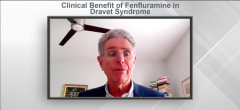
Clinical Benefit of Fenfluramine in Dravet Syndrome
Episodes in this series

Results from a real-world US early access program experience looking at the clinical benefit of fenfluramine in adults vs children and adolescents with Dravet syndrome.
Trevor Resnick, MD: This study is on fenfluramine, or Fintepla, and was also a real-world experience study, but as part of the data coming out of the early access program. This primary author in the study was M. Scott Perry, [MD,] and it was specifically looking at the clinical benefit in both adults and children with Dravet syndrome.
The rationale for this, and the rationale for the early access program, was that in the pivotal studies that were done for Fintepla, the randomized controlled studies in Dravet syndrome were done in patients under 18 years of age. It is more of a childhood adolescent study, and there wasn’t the opportunity for the adult patients with Dravet syndrome to participate in the studies. It is known from the randomized controlled study with Fintepla that there was a profound reduction in seizure frequency, with significantly prolonged seizure-free intervals in those patients who were on Fintepla. These studies enrolled patients who were less than 18 years of age, making data in the adult population limited.
The early access program was initiated to give access to patients, especially the adult patients, who were not eligible to participate in the original trials.
In this prospective, open-label study, Fintepla was added to each of the eligible patient’s anticonvulsant drug regimen, initially at 0.2 mg/kg per day, and then escalated to a maximum of 0.7 mg/kg per day over a period of weeks. The 0.7 mg/kg per day—the maximum dose was 26 mg per day in patients who were not on stiripentol, and 17 mg per day in patients who were on stiripentol because of the drug-drug interaction.
The important focus of this abstract is not specifically on seizure freedom, but on the behavioral, cognitive, and motor aspects of how the patients did on Fintepla. At each study visit, the domains of cognitive function, behavior, motor ability, and global clinical impression of improvement were assessed as compared to the pretreatment period for each of the patients by the treating physician. They used a 7-point Likert scale that ranged from 1, which was very much improved; to 4, no change; or 7, much worse.
Unfortunately, this study suffered from a similar problem to the previous one, in that even though 109 patients with Dravet were entered into the open access program, only 19 of them were above 18 years of age. The median duration of treatment was 90 days, so there was a 3-month period of observation. About 74%, almost three-fourths of the patients, both adults and children, were noted to be improved in terms of the global scales.
When it is broken down even further, looking at the global scales, 32% to 42% of the adults improved, and 41% to 60% of children improved in terms of cognitive function, behavior, and motor function.
The bottom line for this fenfluramine/Fintepla study was to look at cognitive, behavioral, and motor changes, either good or bad, both in the adult group and as compared to children. The results from this real-word, early access program experienced with Fintepla suggest that both adults with Dravet syndrome experienced clinical benefit and tolerability, in addition to which the children, as we already know, also experienced improvements in cognitive, motor, and behavioral function, in a similar pattern to that noticed in the children.
This study provided a nuance of observation that, No. 1, it is known from the pivotal studies that fenfluramine had a significant benefit in children under age 18 for Dravet syndrome as it relates to seizure response. But this descriptive study is saying that not only is there an improvement for children, but there’s also an improvement for adults, above age 18, specifically as it relates to global cognitive, motor, and behavioral indexes.
Newsletter
Keep your finger on the pulse of neurology—subscribe to NeurologyLive for expert interviews, new data, and breakthrough treatment updates.





























